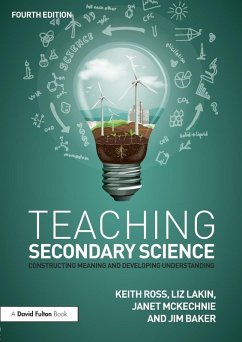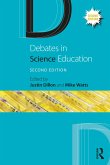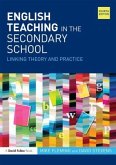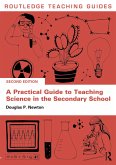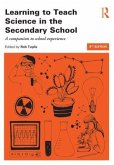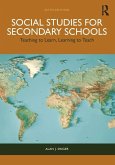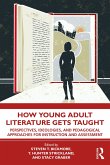Keith Ross (UK University of Gloucestershire and The Fuse School.), Liz Lakin (Senior Lecturer in Education and Life Sciences at the Un, Janet McKechnie
Teaching Secondary Science
Constructing Meaning and Developing Understanding
Keith Ross (UK University of Gloucestershire and The Fuse School.), Liz Lakin (Senior Lecturer in Education and Life Sciences at the Un, Janet McKechnie
Teaching Secondary Science
Constructing Meaning and Developing Understanding
- Broschiertes Buch
- Merkliste
- Auf die Merkliste
- Bewerten Bewerten
- Teilen
- Produkt teilen
- Produkterinnerung
- Produkterinnerung
Teaching Secondary Science is a complete guide to all aspects of science teaching, providing a wealth of information and ideas about different practicable approaches.
Andere Kunden interessierten sich auch für
![Debates in Science Education Debates in Science Education]() Debates in Science Education32,99 €
Debates in Science Education32,99 €![English Teaching in the Secondary School English Teaching in the Secondary School]() Mike Fleming (UK University of Durham)English Teaching in the Secondary School69,99 €
Mike Fleming (UK University of Durham)English Teaching in the Secondary School69,99 €![A Practical Guide to Teaching Science in the Secondary School A Practical Guide to Teaching Science in the Secondary School]() Douglas P. Newton (UK University of Durham)A Practical Guide to Teaching Science in the Secondary School33,99 €
Douglas P. Newton (UK University of Durham)A Practical Guide to Teaching Science in the Secondary School33,99 €![Learning to Teach Science in the Secondary School Learning to Teach Science in the Secondary School]() Learning to Teach Science in the Secondary School64,99 €
Learning to Teach Science in the Secondary School64,99 €![Social Studies for Secondary Schools Social Studies for Secondary Schools]() Alan J. Singer (USA Hofstra University)Social Studies for Secondary Schools68,99 €
Alan J. Singer (USA Hofstra University)Social Studies for Secondary Schools68,99 €![How Young Adult Literature Gets Taught How Young Adult Literature Gets Taught]() How Young Adult Literature Gets Taught41,99 €
How Young Adult Literature Gets Taught41,99 €![Teaching Science in Diverse Classrooms Teaching Science in Diverse Classrooms]() Douglas B. LarkinTeaching Science in Diverse Classrooms56,99 €
Douglas B. LarkinTeaching Science in Diverse Classrooms56,99 €-
-
-
Teaching Secondary Science is a complete guide to all aspects of science teaching, providing a wealth of information and ideas about different practicable approaches.
Produktdetails
- Produktdetails
- Verlag: Taylor & Francis Ltd
- 4 ed
- Seitenzahl: 272
- Erscheinungstermin: 18. Juni 2015
- Englisch
- Abmessung: 246mm x 174mm x 15mm
- Gewicht: 500g
- ISBN-13: 9781138833425
- ISBN-10: 1138833428
- Artikelnr.: 42295812
- Herstellerkennzeichnung
- Libri GmbH
- Europaallee 1
- 36244 Bad Hersfeld
- gpsr@libri.de
- Verlag: Taylor & Francis Ltd
- 4 ed
- Seitenzahl: 272
- Erscheinungstermin: 18. Juni 2015
- Englisch
- Abmessung: 246mm x 174mm x 15mm
- Gewicht: 500g
- ISBN-13: 9781138833425
- ISBN-10: 1138833428
- Artikelnr.: 42295812
- Herstellerkennzeichnung
- Libri GmbH
- Europaallee 1
- 36244 Bad Hersfeld
- gpsr@libri.de
Keith Ross is a former secondary science teacher and Education Teaching Fellow at the University of Gloucestershire, UK. He is currently co-creating four-minute animated science videos with the Fuse School that are free to teachers and students worldwide. www.youtube.com/fuseschool. Liz Lakin is a former secondary science teacher and tutor at the universities of Gloucestershire and Cumbria, UK. She is currently Senior Lecturer in Education and Life Sciences at the University of Dundee, UK. Janet McKechnie is a physics teacher and STEM coordinator at Pate's Grammar School, Cheltenham, UK. She is also former Physics AST and Science Leader for the Secondary Science PGCE at the University of Gloucestershire, UK. Jim Baker is a freelance educational consultant, webmaster, blogger and maverick. With 44 years' experience he has taught science at secondary schools in Lincoln and still teaches part-time. www.jimbakersonlinelearning.co.uk.
Part I - Science and why we teach it: 1. What makes a good science teacher?
2. Working Scientifically 3. Science education and sustainability Part II -
How Pupils Make Sense of Their World: 4. Learning through language and
observation 5. Elicitation: Pupils' ideas of the world 6. A constructivist
approach to learning 7. Active learning techniques 8. Learning through talk
9. Learning through reading 10. Learning through writing 11. Harnessing the
Power of Computers and the Web 12. What if English is not the Mother Tongue
of your students? 13. Numeracy in science Part III - Knowledge and
Understanding: 14. Difficult ideas in chemistry 15. Difficult ideas in
physics 16. Difficult ideas in biology 17. Difficult ideas in earth science
and astronomy PART IV - Planning, Assessment, Teaching and Class
Management: 18. Planning for progression 19. Assessment for Learning in
science 20. Managing pupils in science lessons 21. Health, safety and
laboratory management 22. Teaching and learning at 14-19 PART V -
Professional values and the wider world: 23. Inclusion and science for all:
every child matters 24. Learning outside the classroom 25. Becoming a
professional science teacher
2. Working Scientifically 3. Science education and sustainability Part II -
How Pupils Make Sense of Their World: 4. Learning through language and
observation 5. Elicitation: Pupils' ideas of the world 6. A constructivist
approach to learning 7. Active learning techniques 8. Learning through talk
9. Learning through reading 10. Learning through writing 11. Harnessing the
Power of Computers and the Web 12. What if English is not the Mother Tongue
of your students? 13. Numeracy in science Part III - Knowledge and
Understanding: 14. Difficult ideas in chemistry 15. Difficult ideas in
physics 16. Difficult ideas in biology 17. Difficult ideas in earth science
and astronomy PART IV - Planning, Assessment, Teaching and Class
Management: 18. Planning for progression 19. Assessment for Learning in
science 20. Managing pupils in science lessons 21. Health, safety and
laboratory management 22. Teaching and learning at 14-19 PART V -
Professional values and the wider world: 23. Inclusion and science for all:
every child matters 24. Learning outside the classroom 25. Becoming a
professional science teacher
Part I - Science and why we teach it: 1. What makes a good science teacher?
2. Working Scientifically 3. Science education and sustainability Part II -
How Pupils Make Sense of Their World: 4. Learning through language and
observation 5. Elicitation: Pupils' ideas of the world 6. A constructivist
approach to learning 7. Active learning techniques 8. Learning through talk
9. Learning through reading 10. Learning through writing 11. Harnessing the
Power of Computers and the Web 12. What if English is not the Mother Tongue
of your students? 13. Numeracy in science Part III - Knowledge and
Understanding: 14. Difficult ideas in chemistry 15. Difficult ideas in
physics 16. Difficult ideas in biology 17. Difficult ideas in earth science
and astronomy PART IV - Planning, Assessment, Teaching and Class
Management: 18. Planning for progression 19. Assessment for Learning in
science 20. Managing pupils in science lessons 21. Health, safety and
laboratory management 22. Teaching and learning at 14-19 PART V -
Professional values and the wider world: 23. Inclusion and science for all:
every child matters 24. Learning outside the classroom 25. Becoming a
professional science teacher
2. Working Scientifically 3. Science education and sustainability Part II -
How Pupils Make Sense of Their World: 4. Learning through language and
observation 5. Elicitation: Pupils' ideas of the world 6. A constructivist
approach to learning 7. Active learning techniques 8. Learning through talk
9. Learning through reading 10. Learning through writing 11. Harnessing the
Power of Computers and the Web 12. What if English is not the Mother Tongue
of your students? 13. Numeracy in science Part III - Knowledge and
Understanding: 14. Difficult ideas in chemistry 15. Difficult ideas in
physics 16. Difficult ideas in biology 17. Difficult ideas in earth science
and astronomy PART IV - Planning, Assessment, Teaching and Class
Management: 18. Planning for progression 19. Assessment for Learning in
science 20. Managing pupils in science lessons 21. Health, safety and
laboratory management 22. Teaching and learning at 14-19 PART V -
Professional values and the wider world: 23. Inclusion and science for all:
every child matters 24. Learning outside the classroom 25. Becoming a
professional science teacher

